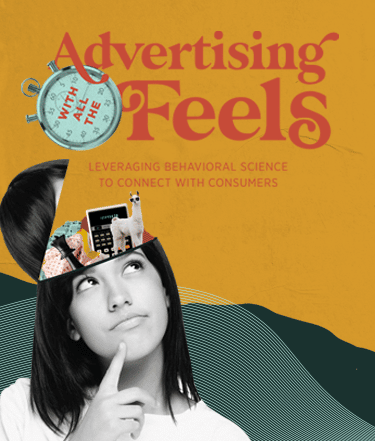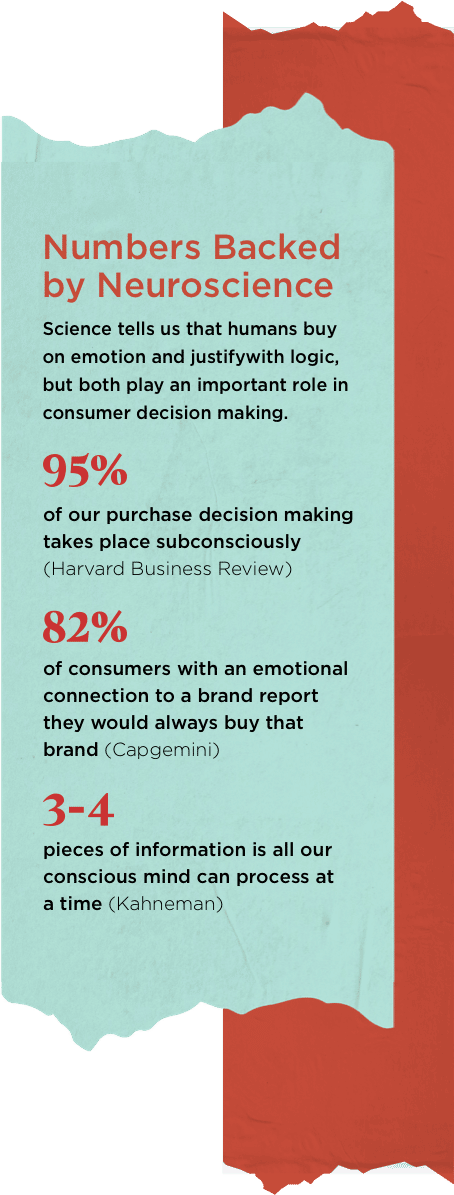Advertising with all the feels


e’ve all done it. Bought that lottery ticket knowing, rationally, that the odds were stacked against us, but unable to resist imagining just how amazing it would feel to actually win.
 e’ve all done it. Bought that lottery ticket knowing, rationally, that the odds were stacked against us, but unable to resist imagining just how amazing it would feel to actually win.
e’ve all done it. Bought that lottery ticket knowing, rationally, that the odds were stacked against us, but unable to resist imagining just how amazing it would feel to actually win.
Of course, being the highly reasonable,
scientific-minded humans we like to think we are, we remind ourselves of the factual evidence to justify our emotional decisions. The odds of winning the lottery may only be 1 in 303 million, but someone’s gotta win, might as well be you, right? (This exact line of reasoning was once the tagline for the Kentucky Lottery, proving that marketers had a keen understanding of the human psyche long before Alexa started learning our habitual behaviors.)
And indeed, there is a science to human decision making. Economist and psychologist Daniel Kahneman even won a Nobel Prize for his work in the field. He summarizes much of his research in his best-selling book Thinking, Fast and Slow. And a lot of it has a great deal of insights that are of particular interest for marketers.
According to Kahneman, the human brain has two distinct operating modes: System 1 is fast, intuitive and emotional. This is our brain on “auto-pilot,” and it’s how we process information most of the time. System 2 is slow, deliberate and effortful. It requires a lot of energy! Therefore, we only use this system when absolutely necessary — about 5% of the time, Kahneman estimates. So although we’d like to believe we’re making decisions in a deliberate, thoughtful manner, most of the time we’re acting on impulse — that System 1 mode of thinking.

What does this
mean for marketers?
If humans are actually relying on their intuition and emotions to make decisions, we can establish more authentic and lasting connections with our audiences if we lean into the emotional aspects of our brands in campaigns and other communications efforts.
But that doesn’t have to mean getting out the guitar and leading everyone in a chorus of “Kumbayah”. After all, “confident” and “empowered” are feelings. So is “funny,” and there are multiple LOLing emojis to express that. You don’t have to look any further than the latest beer commercial to know that humor is a highly effective way of connecting with an audience. GEICO and Aflac have had decades of success using everything from cavemen to talking ducks to sell what has to be one of the most mind-numbingly convoluted products in the world: insurance. (Apologies to any actuaries reading this.)
Still, marketers can’t ignore the needs of the hard-working, logical System 2 brain entirely. This is where behavioral science meets UX. When you create a seamless journey for your consumers across all digital, physical and virtual touchpoints, it becomes easy for their brains to stay in System 1 mode and follow through on the emotional impulses your advertising stimulates in them.
Let’s say our imaginary consumer Dave just saw an inspiring commercial for the International Alpaca Rescue Society. He was so overwhelmed with joy, watching all those happy people feed, groom and walk their rescue alpacas that he’s ready to adopt one now! He picks up his phone and searches for the organization. But it hasn’t invested in its SEO strategy, so he has to scroll to the bottom of the search results. He clicks the link to the site. Whoops, it’s
not a mobile-friendly design. When Dave finally finds the page to inquire about alpaca adoption,there’s a problem submitting the form. Ugh. Dave gives up on alpacas, and begins to think he might be more of a cat person instead.


To use a more real-life example, consider the uber-popular (ahem) ride-sharing service Uber. When the company was founded way back in 2009, getting a taxi meant standing out in the street and and waving your hand until a cab pulled over. Rush hours, rainy days and frigid winters are just a few of the situations that could make this a miserable experience. And if you were in, say, Wichita, Kansas or a similarly more sedate locale, you’d likely have to call the actual taxi service and hope that the cab showed up to get you to the airport in time.
To wit: effectively engaging with consumers requires both logic and magic. Use the magic of emotions to connect with their fast-thinking, automatic System 1 brains. But then use logic to eliminate any barriers on the path to purchase that would cause their rational System 2 brains to kick into gear and question their System 1 decisions. Design with a mobile-first mindset. Make your website simple and intuitive. Create clear, easy paths for actions you want your audience to
take, whether it’s “Add to Cart,” “Subscribe,” or “Adopt Now.”
Uber’s founders knew that was an aggravation for consumers across the country (heck, they were some of them!). And they knew there was room for improvement in the taxi-hailing user experience. By allowing riders to call a cab, view the driver and car, monitor the route, pay and even rate the service using their ever-present smartphones, Uber created a seamless experience for their consumers at every point in the journey. Not only did they eliminate nearly all of the pain points of taxi service (traffic, alas, is still with us), they also made it so easy, the brain could stay in System 1 auto-pilot mode, virtually ensuring it would become a habitual behavior.
B2B, B2C … How about H2H?
Human to Human, that is. Because at the end of the day, both you and your consumers are humans. Putting yourself in their metaphorical shoes helps you create meaningful messaging and engage with them on a more authentic level. Here are a few ways to find that emotional connection:
Think like a human. If your brand were a person, how would you describe it? Friendly? Fun? Honest? That’s the tone you’re looking for in all your communications. Note that “synergistic” and “cost-effective” are not terms we typically use to describe humans.
Cultivate empathy. What are some of your audience’s pain points? What problem could your brand solve for consumers? Uber eliminated the uncertainty of trying to hail a cab from the street — and saved a lot of hairdos on rainy days.
Locate the feeling. What do you want consumers to feel when they interact with your brand? Is it the joy and relief of making their life a little easier? Is it the happiness they get when they treat themselves at the end of a long day? Let that feeling come across in all your advertising and marketing materials.
Avoid the hard sell. There’s a fine line between providing transparency with a clear call-to-action and hitting the sales messaging a little too hard. Consumers know you’re vying to get their money. Make consumer interactions enjoyable by playing with your brand personality.
Try the bar stool pitch. If you were sitting next to a friend, enjoying a beer or mocktail, how would you sell her on your brand? It would be conversational, and full of enthusiasm. You might not be able to tell her all the engine specs on your new car, for instance, but you’d definitely be able to describe how utterly awesome it feels to take it out on the interstate and really open it up. That’s the kind of authentic, emotive feeling we’re going for here.